Aotearoa Press Release
As the world burns, global military spending exceeds $2 trillion
Peace Movement Aotearoa
25 April 2022
As the world burns and sea levels rise, global military spending increased to more than $2 trillion (US) in 2021, according to figures released by the Stockholm International Peace Research Institute (SIPRI) today – the Global Day of Action on Military Spending.
SIPRI has estimated global military expenditure last year was at least $2,113 billion (US), the first time it has exceeded $2 trillion (US): an average of more than $5.78 billion (US) every day. This comprised a 6.1% nominal increase since 2020 (0.7% when adjusted for inflation). [1]
By way of contrast, on average 14,000 children under the age of five died every day last year from mainly preventable causes – lack of access to adequate food, clean water and basic medicines – a figure UNICEF describes as “unconscionable”. [2] This is one of the prices paid, the collateral damage that is seldom talked about, for maintaining armed forces in a state of combat readiness around the world.
It is inexcusable that many states – including New Zealand – continue to prioritise spending on combat-ready armed forces over human health and wellbeing, and care for the planet. Over the past two years the COVID-19 pandemic has devastated lives and livelihoods around the world, highlighted and exacerbated systemic social, economic and political inequities, and exposed multiple flaws in government spending and other priorities, including the folly of maintaining armed forces in a constant state of combat readiness when there are so many other more pressing needs.
It is more obvious than ever before that military spending does nothing to address the major global threats and their local impacts, whether a pandemic, obscene levels of poverty and social inequality, or the escalating climate catastrophe – instead, military spending diverts resources that could be put to far better use.
Every dollar of military expenditure is a dollar taken away from socially useful spending – a dollar that could be used to take real action on climate change, to ensure a decent standard of living for all, and to ensure health and social welfare systems can function well in national, regional or global emergencies: it is a dollar that could be used to save lives, to promote flourishing communities and care for the planet, rather than being spent on endless preparations for war.
The five largest spenders in 2021 were the US, China, India, Britain and Russia, which together accounted for 62% of world military spending, while the US and China accounted for 52%. [1] Military expenditure increased in three of the world’s five regions in 2021 – Asia and Oceania (3.5%), Europe (3.0%) and Africa (1.2 %) – while decreasing in the Middle East (-3.3 %) and the Americas (1.2 %). Overall in 2021, the military burden (military expenditure as a share of gross domestic product), was 2.2%, while average military spending as a share of government expenditure was 5.9 %. [1]

New Zealand’s military spending
While New Zealand does not feature in the SIPRI table ranking the highest increases in military spending around the world this year as it did in 2020 [3], that is simply because other states increased their spending by more, not because there has been any reduction in New Zealand’s military spending.
Even before the COVID-19 pandemic, essential public services including health, education, support for persons with disabilities, and housing desperately needed increased spending, yet the New Zealand government continues to prioritise military spending.
In last year’s ‘Wellbeing’ Budget, military spending was a total of $5,188,350,000 (NZ), on average $99.7 million (NZ) every week – a 10.6% increase on actual spending in 2020. [4] The spectre of an additional $20 billion (NZ) to be spent over the next decade on increased combat capability, warships and military aircraft continues to threaten the possibility of substantive action on human health and wellbeing, and climate justice. [4]
The ongoing prioritising of military spending – whether here in Aotearoa or around the world – is a reflection of a dominant violent ideology that focuses on outdated narrow military security concepts, rather than real human security that meets the needs of all, and it continues to harm the future of humanity and the planet.
It is truly shameful that military spending continues to rise in the midst of a global pandemic and rapidly worsening climate catastrophe – a transition from combat-ready armed forces to civilian agencies that meet the needs of all peoples and the planet is long overdue. [5]
The IPCC has warned [6] the time for action is now if we want to have a liveable future: it is time to invest in the future for peoples and planet, and budget for peace – not war.
Resources and references:
- Aotearoa New Zealand Campaign on Military Spending, http://www.converge.org.nz/pma/gdams.htm
- SIPRI, https://www.sipri.org
- Share: Facebook, https://www.facebook.com/PeaceMovementAotearoa/posts/5033024826744846 Tweet, https://twitter.com/PeaceMovementA/status/1518353319835578368
[1] ‘World military expenditure passes $2 trillion for first time’, SIPRI, 25 April 2022, and ‘Trends in world military expenditure 2021’, SIPRI Fact Sheet, April 2022, both are available at http://www.converge.org.nz/pma/gdams.htm
[2] ‘Levels and Trends in Child Mortality: Report 2021’, UN Inter-Agency Group for Child Mortality Estimation, December 2021, https://data.unicef.org/resources/levels-and-trends-in-child-mortality/
[3] ‘Global military spending increases, New Zealand ranks in report’, Peace Movement Aotearoa, 27 April 2020, http://www.converge.org.nz/pma/nzgdams2020.pdf
[4] ‘Military spending increases in Budget 2021’, Peace Movement Aotearoa, 20 May 2021, http://www.converge.org.nz/pma/nzbudget2021.pdf
[5] As outlined, for example, in ‘Military spending increases in Budget 2021’, note above.
[6] See, for example, The evidence is clear: the time for action is now’, IPCC, 4 April 2022, https://www.ipcc.ch/2022/04/04/ipcc-ar6-wgiii-pressrelease



